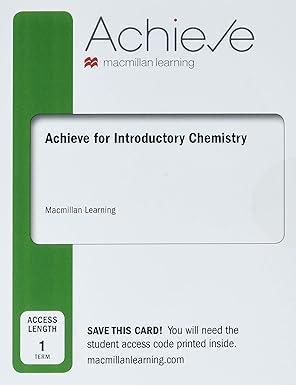Question
17. In the following table: a. The ionic symbol is incorrect. b. The atomic number is incorrect. c. The number of protons is incorrect. d.
17. In the following table: a. The ionic symbol is incorrect. b. The atomic number is incorrect. c. The number of protons is incorrect. d. The number of electrons is incorrect. e. The charge is incorrect. f. Everything is correct.
18. Which of the following is an example of a physical change? a. adding vinegar to baking soda and producing carbon dioxide b. grinding sucrose crystals and producing powdered sugar c. smoking tobacco and producing smoke and ash d. digesting starch and producing glucose sugar
19. What is the term for the shorthand description of the arrangement of electrons by sublevels according to increasing energy? a. atomic notation b. atomic number c. continuous spectrum d. electron configuration
20. Which of the following subatomic particles are found inside the nucleus? a. electron and neutron b. neutron and proton c. proton and electron d. all of the above
21. State whether this statement is True or False: a. A homogeneous mixture has regions that are different in composition or phase. (T/F) b. The scientific method is used to make theories that can no longer be changed.(T/F)
22. Which of the following is a compound? a. water b. oxygen c. heat d. salad dressing e. nitrogen
23. To gather information to support or discredit a hypothesis, a scientist a. conducts experiments b. consults an authority c. establishes a scientific law d. formulates a scientific theory
24. A compound can be separated into its elements a. by chemical means b. by mechanical means c. by physical means d. using a magnet
25. A rope is 5.775 cm long. What is its length in millimetres? (Hint: check conversion table in slides) a. 0.05775 mm b. 0.5775 mm c. 5.775 mm d. 57.75 mm
26. Heat is a. an element b. the energy flow from a hot object to a cold one c. a measure of energy intensity d. a temperature above room temperature
27. To convert a temperature on the Kelvin scale to degrees Celsius, we ( check slides ) a. add 100 b. add 273 c. subtract 100 d. subtract 273
28. The SI scale for temperature is known as the a. Celsius scale b. Fahrenheit scale c. Kelvin scale d. Richter scale
29. A molecule is a. a collection of like atoms b. conserved in chemical reactions c. a group of atoms chemically bonded to one another d. indivisible
30. During electrolysis of molten sodium chloride, chloride anions Cl- a. anode, which is negatively charged b. anode, which is positively charged c. cathode, which is negatively charged d. cathode, which is positively charged
31. Rutherfords gold-foil experiment showed that a. gold atoms consisted of electrons in a pudding of positive charge b. the nucleus was huge and positively charged c. the nucleus was tiny and positively charged d. some gold atoms were shattered by alpha particles
32. The identity of an element is determined by its a. atomic mass b. number of atoms c. number of electrons d. number of protons
33. A change in the number of neutrons in an atom produces a. compound b. atom of a different element c. ion d. different isotope of the same element
34. A molecule of water contains hydrogen and oxygen in a 1:8 ratio by mass. This is a statement of ________. a. The law of multiple proportions b. The law of constant composition c. The law of conservation of mass d. The law of conservation of energy
35. Which one of the following is NOT one of the postulates of Dalton's atomic theory? a. Atoms are composed of protons, neutrons, and electrons. b. All atoms of a given element are identical; the atoms of different elements are different and have different properties. c. Atoms of an element are not changed into different types of atoms by chemical reactions: atoms are neither created nor destroyed in chemical reactions. d. Compounds are formed when atoms of more than one element combine; a given compound always has the same relative number and kind of atoms. e. Each element is composed of extremely small particles called atoms.
Step by Step Solution
There are 3 Steps involved in it
Step: 1

Get Instant Access to Expert-Tailored Solutions
See step-by-step solutions with expert insights and AI powered tools for academic success
Step: 2

Step: 3

Ace Your Homework with AI
Get the answers you need in no time with our AI-driven, step-by-step assistance
Get Started


